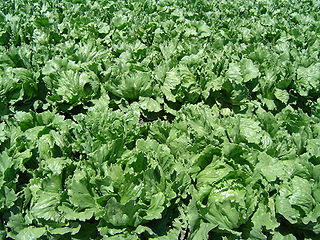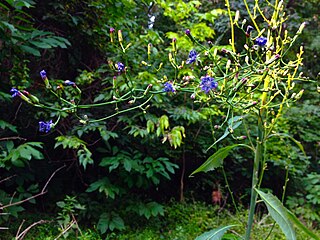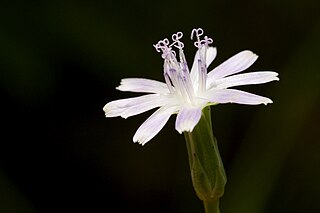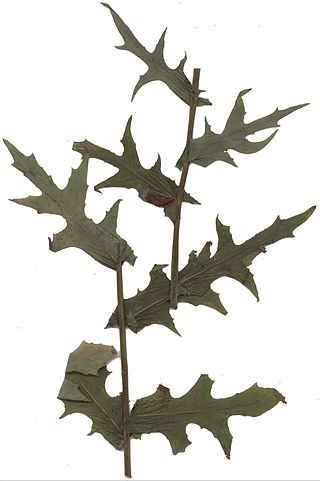
Lettuce is an annual plant of the family Asteraceae. It is most often grown as a leaf vegetable, but sometimes for its stem and seeds. Lettuce is most often used for salads, although it is also seen in other kinds of food, such as soups, sandwiches and wraps; it can also be grilled. One variety, celtuce, is grown for its stems, which are eaten either raw or cooked. In addition to its main use as a leafy green, it has also gathered religious and medicinal significance over centuries of human consumption. Europe and North America originally dominated the market for lettuce, but by the late 20th century the consumption of lettuce had spread throughout the world. As of 2021, world production of lettuce and chicory was 27 million tonnes, 53 percent of which came from China.

Lactuca, commonly known as lettuce, is a genus of flowering plants in the family Asteraceae. The genus includes at least 50 species, distributed worldwide, but mainly in temperate Eurasia.
Lactucarium is the milky fluid secreted by several species of lettuce, especially Lactuca virosa, usually from the base of the stems. It is known as lettuce opium because of its sedative and analgesic properties. It has also been reported to promote a mild sensation of euphoria. Because it is a latex, lactucarium physically resembles opium, in that it is excreted as a white fluid and can be reduced to a thick smokable solid.

Cannabis sativa is an annual herbaceous flowering plant indigenous to Eastern Asia, but now of cosmopolitan distribution due to widespread cultivation. It has been cultivated throughout recorded history, used as a source of industrial fiber, seed oil, food, recreation, religious and spiritual moods and medicine. Each part of the plant is harvested differently, depending on the purpose of its use. The species was first classified by Carl Linnaeus in 1753. The word sativa means "things that are cultivated."

Lactucopicrin (Intybin) is a bitter substance that has a sedative and analgesic effect, acting on the central nervous system. It is a sesquiterpene lactone, and is a component of lactucarium, derived from the plant Lactuca virosa, as well as being found in some related plants such as Cichorium intybus. It is also found in dandelion coffee.
Opium lettuce refers to several plants in the lettuce genus (Lactuca) producing a lactucarium that has been used as a sedative and analgesic:

Lactuca serriola, also called prickly lettuce, milk thistle, compass plant, and scarole, is an annual or biennial plant in the tribe Cichorieae within the family Asteraceae. It has a slightly fetid odor and is commonly considered a weed of orchards, roadsides and field crops. It is the closest wild relative of cultivated lettuce.
Wild lettuce is a common name for several lactucarium-containing plants related to lettuce. The name most often refers to Lactuca virosa, though it may also refer to:

Bremia lactucae is a plant pathogen. This microorganism causes a disease of lettuce denominated as downy mildew. Some other strains can be found on 36 genera of Asteraceae including Senecio and Sonchus. Experiments using sporangia from hosts do not infect lettuce and it is concluded that the fungus exists as a quantity of host-specific strains. Wild species, such as Lactuca serriola, or varieties of Lactuca can hold strains that infect lettuce, but these pathogens are not sufficiently common to seriously infect the plant.

Lactuca canadensis is a species of wild lettuce known by the common names Canada lettuce, Canada wild lettuce, and tall lettuce. Its true native range is not clear, but it is considered to be a native of the eastern and central parts of North America. It naturalized in the western part of the continent as well as in Eurasia.

Lactuca saligna is a species of wild lettuce known by the common name willowleaf lettuce, and least lettuce. It is native to Eurasia but it grows in many other places as an introduced species, including much of North America.

Lactuca muralis, the wall lettuce, is a perennial flowering plant in the tribe Cichorieae within the family Asteraceae, also referred to as Mycelis muralis.

Nabalus is a genus of Asian and North American flowering plants in the tribe Cichorieae within the family Asteraceae.

Lactuca perennis, common names: mountain lettuce, blue lettuce or perennial lettuce, is a perennial herbaceous plant species belonging to the genus Lactuca of the family Asteraceae. It is widespread across most of central and southern Europe. Its leaves are edible.

China is the world leader in lettuce production, producing half of the world's lettuce. Stem lettuce is grown in the country and the stems are prepared as a cooked vegetable. According to estimates given by the Food and Agriculture Organization (FAO) in 2006, China produced around 11,005,000 metric tonnes of lettuce on 500,250 hectares of land. In 2010, the FAO reported that some 12,574,500 tonnes of lettuce were produced during that year. Taiwan is also a producer of good quality head lettuce, which is an export commodity.

Lactuca floridana, commonly known as woodland lettuce, Florida lettuce, or false lettuce is a North American species of wild lettuce. It is native across much of central Canada and the eastern and central United States.

Lactuca graminifolia, the grassleaf lettuce is a North American species of wild lettuce. It grows in Mexico, Central America, Hispaniola, and the southern United States from Arizona to Florida, Virginia and the Carolinas.

Lactuca ludoviciana, the biannual lettuce, is a North American species of wild lettuce. It is widespread across much of central and western Canada and the western and central United States from Ontario west to British Columbia and south to Louisiana, Texas, and California. Most of the known populations are on the Great Plains; populations west of there may well represent naturalizations.

Lactuca quercina is a species of wild lettuce native to Europe and Asia. It is an annual or biennial herb in the tribe Cichorieae within the family Asteraceae growing from a taproot to maximum heights of 50–200 cm (19.5–78.5 in) or more.
Lactuca aculeata is a species of wild lettuce native to Anatolia, the Levant, Iraq and Iran. A very prickly plant, it is closely related to Lactuca serriola and Lactuca sativa, and can readily interbreed with them. It is possible that Lactuca aculeata contributed to the gene pool of cultivated lettuce.

















